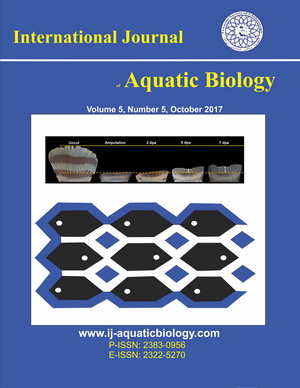A comparative study of photography and mud excavation methods for estimating population density, sex ratio, body size, and claw size of the fiddler crab Austruca perplexa (Brachyura, Ocypodidae)
Downloads
Though fiddler crabs are considered ecosystem engineers in mangroves, accurately estimating their density, sex ratio, and body sizes is challenging. The conventional method of mud excavation is frequently employed to estimate these parameters, yet it proves destructive because it destroys crab burrows and stresses the crabs. In this study, we compared a non-destructive photography method with the mud excavation method in a fiddler crab, Austruca perplexa, population in southern Thailand. Ten 0.25 m2 quadrats were fixed, and 4 photographs of the crabs inside each quadrat were taken. Subsequently, the mud within the quadrat was excavated to 30 cm, and all crabs were collected. Parameters such as crab numbers, sexes, body sizes, male handedness (right/left major claws), and male major claw sizes were estimated. Afterward, the photographs were processed in GIMP (GNU Image Manipulation Program) to estimate the same parameters. These parameters were then compared between the two methods. We observed that the photography method was as effective as the mud excavation method in measuring most parameters, except female density, which was higher in the mud excavation method. This study reveals that the photography method could be used effectively instead of the mud excavation method in estimating several population parameters in fiddler crabs while acknowledging its limitation in accurately estimating female density.
Downloads
Backwell P., Jennions M., Wada K., Murai M., Christy J. (2006). Synchronous waving in two species of fiddler crabs. Acta Ethologica, 9: 22-25.
Brown M.B., Wells E. (2020). Skeletal dysplasia-like syndromes in wild giraffe. BMC Research Notes, 13: 1-6.
Christy J.H., Salmon M. (1984). Ecology and evolution of mating systems of fiddler crabs (Genus Uca). Biological Reviews, 59(4): 483-509.
Christy J.H., Salmon M. (1991). Comparative studies of reproductive behavior in mantis shrimps and fiddler crabs. American Zoologist, 31(2): 329-337.
Costa T.M., Negreiros-Fransozo M.L. (2003). Population biology of Uca thayeri Rathbun, 1900 (Brachyura, Ocypodidae) in a subtropical South American mangrove area: results from transect and catch-per-unit-effort techniques. Crustaceana, 75(10): 1201-1218.
Crane J. (1975). Fiddler crabs of the world (Ocypodidae: genus Uca). Princeton University Press, Princeton.
Dos Reis F.J., De Barros E Silva V., De Lucena R.N., Mendes Cardoso B.A., Nogueira L.C. (2016). Measuring the pain area: an intra- and inter-rater reliability study using image analysis software. Pain Practice 16(1): 24-30.
Frith D.W., Brunenmeister S. (1980). Ecological and population studies of fiddler crabs (Ocypodidae: genus Uca) on a mangrove shore at Phuket Island, western Peninsular Thailand. Crustaceana, 39: 157-184.
Hartnoll R.G., Cannici S., Emmerson W.D., Fratini S., Macia A., Mgaya Y., Porri F., Ruwa R.K., Shunula J.P., Skov M.W., Vannini M. (2002). Geographic trends in mangrove crab abundance in east Africa. Wetlands Ecology and Management, 10: 203-213.
Henmi Y. (2003). Trade-off between brood size and brood interval and the evolution of underground incubation in three fiddler crabs (Uca perplexa, U. vocans, and U. dussumieri). Journal of Crustacean Biology, 23(1): 46-54.
Hubbard C.R. (2008). A comparison of invasive and non-invasive techniques for measuring fiddler crab density in a salt marsh. M.Sc. thesis, Georgia Southern University, Statesboro, USA.
Jordão J.M., Oliveira R.F. (2003). Comparison of non-invasive methods for quantifying population density of the fiddler crab Uca tangeri. Journal of the Marine Biological Association of the United Kingdom, 83(5): 981-982.
Keeratipattarakarn K., Tina F.W., Sangngam R., Thongsri K., Suphap A. (2021). ‘Photography’as a useful method for estimating the density, sex-ratio and body size of the surface-active Austruca perplexa (H. Milne Edwards, 1852) (Brachyura, Ocypodidae). Crustaceana, 94: 1429-1440.
Kristensen E. (2008). Mangrove crabs as ecosystem engineers; with emphasis on sediment processes. Journal of sea Research, 59(1-2): 30-43.
Litulo C. (2006). Population and reproductive biology of the fiddler crab Uca chlorophthalmus (Brachyura: Ocypodidae) from Inhaca Island, southern Mozambique. Journal of the Marine Biological Association of the United Kingdom, 86(4): 737-742.
Macia A., Ivaldo Q., Paula J. (2001). A comparison of alternative methods for estimating population density of the fiddler crab Uca annulipes at Saco mangrove, Inhaca Island (Mozambique). Hydrobiologia, 449: 213-219.
Murai M., Backwell P.R. (2006). A conspicuous courtship signal in the fiddler crab Uca perplexa: female choice based on display structure. Behavioral Ecology and Sociobiology, 60: 736-741.
Murai M., Goshima S., Kawai K., Yong H.S. (1996). Pair formation in the burrows of the fiddler crab Uca rosea (Decapoda: Ocypodidae). Journal of Crustacean Biology, 16(3): 522-52.
Nakasone Y., Murai M. (1998). Mating behaviour of Uca lactea perplexa (Decapoda: Ocypodidae). Journal of Crustacean Biology, 18 (1): 70-77. Silva W., Calado T. (2013). Number of ghost crab burrows does not correspond to population size. Open Life Sciences, 8(9): 843-847.
Skov M.W., Hartnoll R.G. (2001). Comparative suitability of binocular observation, burrow counting and excavation for the quantification of the mangrove fiddler crab Uca annulipes (H. Milne Edwards). Hydrobiologia, 449: 201-222. Smith N.F., Wilcox C., Lessmann J.M. (2009). Fiddler crab burrowing affects growth and production of the white mangrove (Laguncularia racemosa) in a restored Florida coastal marsh. Marine Biology, 156: 2255-2266.
Tina F.W., Jaroensutasinee M., Jaroensutasinee K. (2016). A note on behavioural and morphological compensations of male Uca vocans (Linnaeus, 1758) relative to females, for the loss of one functional feeding claw. Crustaceana, 89(8): 975-981.
Tina F.W., Jaroensutasinee M., Jaroensutasinee K. (2018). Claw regeneration, waving display and burrow characteristics of Austruca perplexa (H. Milne Edwards, 1852) (Brachyura, Ocypodidae) from southern Thailand. Crustaceana, 91(10): 1247-1257.
Tina F.W., Keeratipattarakarn K., Jaroensutasinee M., Jaroensutasinee K. (2019). Time allocations for different activities in the fiddler crab Tubuca rosea (Tweedie, 1937) (Brachyura, Ocypodidae). Journal of Animal Behaviour and Biometeorology, 7: 60-65.
Tina F.W., Muramatsu D. (2022). Males signal their breeding burrow characteristics to females in the fiddler crab Austruca perplexa. Behaviour, 159(11): 1045-1062.
Copyright (c) 2024 International Journal of Aquatic Biology

This work is licensed under a Creative Commons Attribution 4.0 International License.








